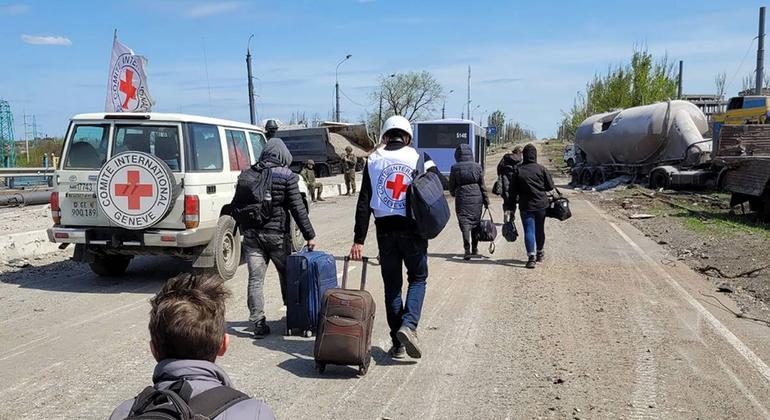In Ukraine on Tuesday, UN humanitarians began to help the first evacuees arriving from Mariupol’s devastated Azovstal steel works, more than two months since Russia’s invasion began, and said that they would do everything possible to assist those still trapped.
“I’m relieved to confirm that the safe passage operation from Mariupol has been successful. “The people I travelled with told me heartbreaking stories of the hell they went through” tweeted Osnat Lubrani, the UN’s top aid official in Ukraine.
I’m relieved to confirm that the safe passage operation from Mariupol has been successful.
The people I travelled with told me heartbreaking stories of the hell they went through.I’m thinking about the people who remain trapped. We will do all we can to assist them. pic.twitter.com/mEqTTKZKA8
— Osnat Lubrani (@OsnatLubrani) May 3, 2022
Ms. Lubrani noted that 101 civilians had been evacuated from the steel plant and other areas in Mariupol, in an operation which began on Friday, coordinated by the UN and the International Committee of the Red Cross (ICRC), in line with commitments made following the Secretary-General’s recent visit to Moscow and Kyiv.
UN aid coordination office, OCHA, also tweeted confirmation that the first evacuees had started to arrive a reception centre in Zaporizhzhia, more than 200 miles north of Mariupol.
A tweet from OCHA on the ground confirmed the buses were on the move on Sunday, coordinated by the UN, the International Committee of the Red Cross (ICRC) and “parties to the conflict.”
Mercy dash
Ahead of the Azovstal steel plant arrivals at Zaporizhzhia reception centre, Dr Dorit Nizan, World Health Organization (WHO) Incident Manager for Ukraine, reported seeing many other civilians from towns and villages on the outskirts of western Mariupol.
“We are already receiving people, mainly mothers and children from Mariupol and its vicinity,” she said. “Cars are coming with volunteers from the region here, Zaporizhzhia, that are driving them from the contact line.”
Before the Russian invasion on 24 February, Mariupol’s population numbered around 500,000. Today, around 100,000 are believed to remain in the battered city, the WHO official said.
Although the majority of these arrivals had only minor injuries which required medical care, mental health linked to the trauma of the war “is a big issue” which will require care and support in the longer term, the WHO official explained.
Fleeing the ‘contact line’
Since the start of the war, the UN health agency has delivered 382 tonnes of medical supplies to Ukraine, including 291 tonnes that have already reached beneficiaries. The agency has established hubs across the vast country, including in Lviv, Kyiv, Dnipro, Donetsk and Luhansk.
“Many people left these regions because they are close to the contact line, and they are you know, under fight(ing) and shelling,” Dr Nizan said. “But many of the health workers stayed to deliver, to help, and those that left are replaced by other health care workers that came from the other areas that were occupied.”
Latest data from the WHO indicates that there have been 186 attacks on health care in Ukraine since 24 February, causing 73 deaths and 52 injuries. Heavy weapons were responsible for the vast majority.

